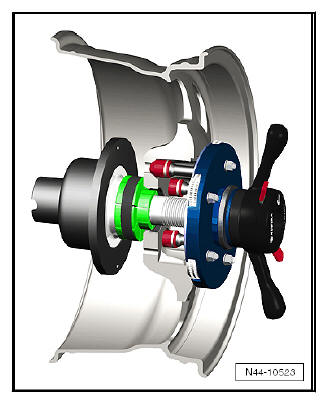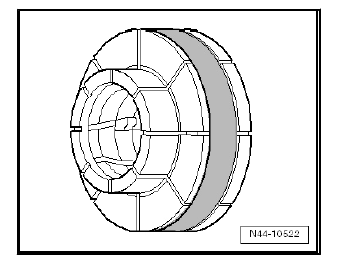Seat Leon >> Balancing wheel
Balancing wheel, conditions
Before balancing the wheels /tyres, the following conditions should be met:
- Tyre pressure must be OK.
- Tread must not be worn on one side. Tread depth should be at least 4 mm.
- The tyre should not in any way be cut, punctured or contain foreign bodies, etc.
- Wheel suspension and steering, including shock absorbers, must be in perfect condition.
- A test drive should first be made.
Balancing wheel, balancing wheel on stationary wheel balancer
- Road test has been carried out
Clamp wheel into wheel balancing machine
Note When balancing tyres, please remember that cleanliness is absolutely essential, as indeed it is in the case of any other repair work you carry out. Only then can you attain a flawless result!
Dirt and rust in the area of the contact surfaces and centre of the wheel distort the result.
- The bearing surface, the centring and the ratchet wrench, for example with the pneumatic brush grinder set - VAS 6446- ⇒ Seat ServiceNet; Workshop Equipment, catalogue clean before the wheel is mounted to the balancing machine!
Note
It is very important that the correct tools for centring and clamping the wheels are used on the wheel balancing system. Before commencing any work, find out about the respective centring system for wheel balancing machines - Volkswagen ServiceNet; Workshop Equipment, Catalogue .
- Attach the wheel (together with tyre) to the wheel balancing machine.

Note
- To clamp the wheel in place, use centring system for wheel balancing machines - VAS 5271- , for example.
- This ensures that the wheel is 100% centred and that the wheel will be clamped without damage!
- The wheel cannot be centralised 100% with conical clamping elements on the wheel balancing machine.
- A centring arrow of 0.1 mm corresponds to an imbalance of 10 g.

Procedure for balancing the wheel rim / tyre
- Allow the wheel (together with tyre) to rotate on the wheel balancing machine.
- Check that the indicator lines on the sidewall of the tyre near the rim flange run evenly.
- Check that the body of the tyre runs evenly while the wheel and tyre are rotating.
Note If one-sided wear, flat spots from braking or severe erosion is apparent, balancing will not be able to achieve smooth running. In this case, the tyre must be renewed.
- Check true running of the wheel/tyre. If not all the wheel turns in a concentric manner, and if no flattening has been detected, there may be radial or axial run-out.
- Check the wheel for radial or lateral runout .
- If the radial and axial run-out do not exceed the permitted tolerance levels, balance the wheel and the tyre.
Note
- Do not attach counterweights of over 60 g to the wheels.
- If a higher weight is required, a better balance can be achieved through matching the tyres.
- The display on the balancing equipment should read 0 grammes.
- As an alternative to match mounting, you could use the vibration control system - VAS 6230 A- .
- Bolt the wheel to the vehicle.
- First, hand-tighten the lowest wheel bolt to about 30Nm.
- Then, tighten the remaining wheel bolts diagonally to about 30Nm. This process centres the wheel on the hub.
- Lower vehicle onto its wheels.
- Now use the torque wrench to firmly tighten the wheel bolts diagonally to the prescribed torque.
Test drive.
- After balancing the wheel/tyre, carry out a road test.
If any imbalance is detected during the test drive, this may be due to tolerances in the centre of the wheel.
In unfavourable circumstances, the tolerances of the wheel components and the wheel hubs may be added together, this can also cause imbalance while driving. This can be alleviated using a finish balancer.
Balancing wheel, balancing wheel with finish balancer
Note
- Before working with a finish balancer , the mechanic needs to have been instructed by the manufacturer of the balancer.
- To balance the wheels, set the wheels of the driven axle on the sensor platforms. On front-wheel drive models, front wheels must be set. On four-wheel drive models, all 4 wheels must be set.
If a residual imbalance of over 20 grammes is detected during the balancing procedure, the wheel should be turned on the wheel hub.
- Mark the point at which the imbalance is indicated.
- Then, unbolt the wheel and rotate its position on the hub so that the marking points downwards.
Note The wheel hub should not rotate during this process.
- First, hand-tighten the lowest wheel bolt to about 30Nm.
- Then, tighten the remaining wheel bolts diagonally to about 30Nm. This process centres the correctly wheel on the hub.
- Check whether the imbalance is less than 20 grams using the finish balancer.
Note The counterweight should only be modified if the imbalance is under 20 grammes.
- Loosen the wheel bolts again if necessary.
- Rotate wheel again by 1 or 2 wheel bolt holes in relation to wheel hub.
- Tighten wheels using the method described above.
Note You should only make corrections by changing the if the imbalance is smaller than 20 grams.
- Balance the wheels until the imbalance is less than 5 grams.
- Tighten wheel bolts to specified torque if you have not already done so.
| WARNING Always tighten wheel bolts to specified tightening torque using a torque wrench! |
Vibration control system
The vibration control system - VAS 6230A- has a range of additional features over and above regular static wheel balancing.
A special feature of this system is the testing of the radial force of the wheel and tyre while rolling.
For this purpose, a roller presses against the wheel with a force of approx. 635 kg. In this way, the vertical force applied by the tyre onto the road while driving is simulated.
The contact forces on the tyre vary due to variations in the stiffness of the tyre and the degree of radial and lateral run-out on the wheel/tyre.
The -VAS 6230A- detects and memorises the position of maximum measured radial force in the tyre. It then locates the smallest measurement between the wheel flange and the centre of the rim.

 Causes of imbalance when driving
Causes of imbalance when driving
The causes for the unevenness during the journey are varied: ride
disturbance may also be caused by tyre wear. Tyre wear caused
by driving is not always evenly spread across the entire running
surf ...
 Checking radial and lateral runout of
wheels and tyres
Checking radial and lateral runout of
wheels and tyres
Checking radial and lateral runout of
wheels and tyres, tolerances
Radial and lateral runout occur when the wheel and tyre do not
run absolutely true.
For technical reasons, 100% true running is ...
See also:
Removing and installing front parking
aid senders
Removing
Switch off ignition and all electrical consumers.
Vehicles without access and start authorisation system
Remove ignition key, if fitted.
Vehicles with access and start authorisa ...
